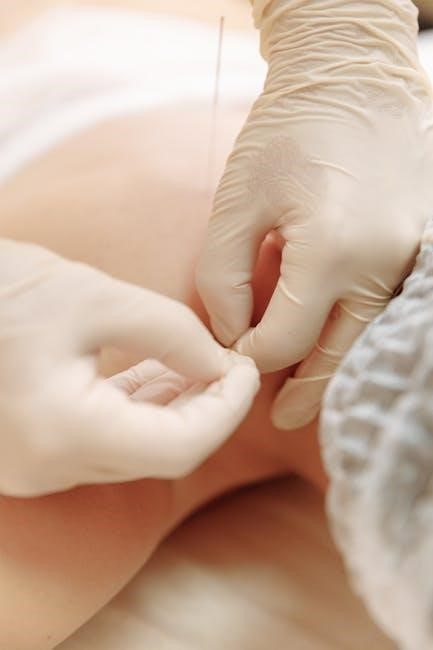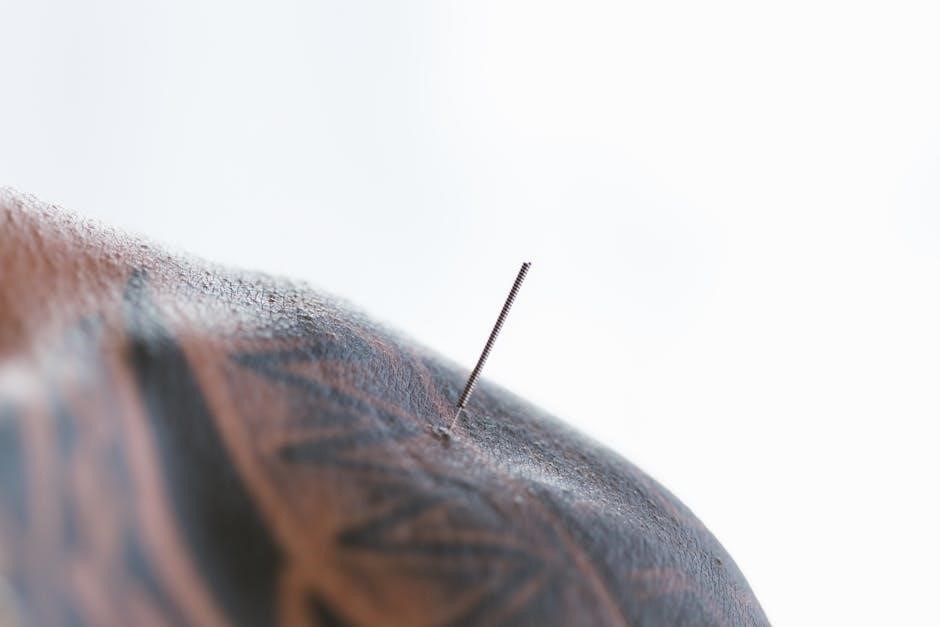dermatome and myotome pdf
A dermatome is an area of skin supplied by a single spinal nerve. Think of it as a map where each area represents sensation from a nerve root.
A myotome is a group of muscles innervated by a single spinal nerve root. This is essential for assessing motor function and nerve integrity in patients.
Definition of Dermatome
A dermatome is a specific area of skin that is primarily innervated by a single spinal nerve. Each spinal nerve, exiting the spinal cord, has a corresponding dermatome that it supplies with sensory information, such as touch, temperature, and pain. Understanding dermatomes is crucial in clinical settings because it allows healthcare professionals to assess the level and extent of nerve damage or spinal cord injuries.
The concept of dermatomes is based on the embryological development of the somites, where cells differentiate into myotomes, dermatomes, and sclerotomes. These dermatomal patterns are consistent across individuals, although slight variations may exist. Dermatomes can be mapped, creating dermatome charts that serve as valuable diagnostic tools. These charts help clinicians correlate sensory deficits with specific spinal nerve roots, enabling accurate diagnosis and targeted treatment plans for neurological conditions.

Dermatomes and Myotomes: An Overview
Definition of Myotome
A myotome is defined as a group of muscles primarily innervated by a single spinal nerve root. Essentially, it represents all the muscles that receive their motor signals from one specific level of the spinal cord. Myotomes are crucial for assessing motor function during neurological examinations, especially when radiculopathy or nerve root impingement is suspected. Understanding the myotomal distribution helps clinicians identify the specific nerve root involved based on observed muscle weakness.
Unlike dermatomes, which are sensory regions, myotomes relate to motor control. Myotome testing involves evaluating the strength of key muscles associated with each spinal nerve root. This assessment aids in localizing lesions within the spinal cord or peripheral nerves. Due to overlapping innervation, testing myotomes can be more complex than testing dermatomes, but it provides vital information for diagnosing and managing neuromuscular disorders.
Dermatome maps visually represent areas of skin innervated by specific spinal nerves. These charts are essential for diagnosing nerve damage and understanding sensory distribution across the body.
Purpose of Dermatome Maps
The primary purpose of dermatome maps is to provide a visual reference for clinicians to understand the sensory distribution of spinal nerves. These maps illustrate which areas of the skin are innervated by specific nerve roots, aiding in the diagnosis of neurological conditions.
By examining a dermatome map, healthcare professionals can identify potential nerve damage or spinal cord injuries based on a patient’s reported sensory deficits. The maps help correlate specific areas of altered sensation with the corresponding nerve root, narrowing down the location of the lesion.
Dermatome maps are also crucial in planning surgical interventions and rehabilitation strategies. Understanding the precise innervation patterns allows for targeted treatment approaches, improving patient outcomes. They assist in localizing lesions within the central nervous tissue, injuries to specific back nerves, and determining the extent of the injury.
Furthermore, these maps serve as educational tools for medical students and patients, enhancing their understanding of the nervous system and related conditions. They provide a clear, visual representation of complex anatomical relationships, facilitating effective communication between healthcare providers and patients.
How to Use a Dermatome Map
To effectively use a dermatome map, begin by familiarizing yourself with the anatomical landmarks and their corresponding nerve root levels. Start by identifying the patient’s area of sensory loss or altered sensation.
Next, refer to the dermatome map to determine which spinal nerve root corresponds to the affected area. Compare the patient’s symptoms to the map to identify potential nerve involvement. Use tools like pinpricks or light touch to test sensation within the suspected dermatome.
Assess the patient’s sensory response and compare it to the expected sensation for that dermatome. Document any discrepancies or abnormalities, such as increased or decreased sensitivity, or complete loss of sensation. Note the specific boundaries of the affected area.
Consider the possibility of overlapping dermatomes, where adjacent nerve roots may also contribute to sensation in the same area. Use the map to guide further neurological examination, including myotome testing, to assess motor function. Integrate findings from the dermatome map with the patient’s clinical presentation and other diagnostic tests to reach an accurate diagnosis.
Dermatome Maps and Charts
Lumbar Dermatome Map
A Lumbar Dermatome Map specifically illustrates the sensory distribution of the lumbar spinal nerves (L1-L5) within the lower back, hips, and legs. It’s a crucial reference for healthcare professionals assessing patients with lower back pain, sciatica, or other lower extremity neurological symptoms.
The L1 dermatome typically covers the groin and upper thigh, while L2 extends down the anterior thigh. L3 includes the medial knee, and L4 runs along the medial lower leg and foot. The L5 dermatome spans the lateral lower leg, the dorsum of the foot, and the first three toes.
Using a lumbar dermatome map, clinicians can pinpoint the affected nerve root based on the patient’s sensory deficits. For instance, numbness along the lateral lower leg may indicate L5 nerve involvement. This targeted assessment helps guide further diagnostic testing and treatment strategies.
Remember that dermatome maps can vary slightly, so familiarity with different versions is beneficial. Always correlate map findings with a thorough clinical exam.

Clinical Significance of Dermatomes
Dermatomes are clinically significant for diagnosing nerve damage and spinal cord injuries; Assessing sensory function within dermatomes helps pinpoint the level and extent of neurological lesions.
Diagnosing Nerve Damage and Spinal Cord Injuries
Dermatomes play a crucial role in diagnosing nerve damage and spinal cord injuries. Because each dermatome corresponds to a specific spinal nerve, assessing sensory function within these areas can help pinpoint the location and extent of neurological lesions. Clinicians evaluate cutaneous feeling with a dermatome map, localizing sores within main nervous tissue. Examining the patient by testing sensation in the dermatome areas indicated on the map will help you locate areas of impaired sensation or nerve injury. This is achieved through sensory testing, such as light touch, pinprick, or temperature discrimination, within specific dermatomal distributions.
If a patient exhibits altered or absent sensation in a particular dermatome, it suggests damage to the corresponding nerve root or spinal cord segment. The dermatome map serves as a guide, enabling healthcare professionals to correlate sensory deficits with specific anatomical locations. This information is invaluable for formulating accurate diagnoses and guiding appropriate treatment strategies. Thus, dermatomes are essential tools for neurologists, physical therapists, and other medical professionals involved in assessing and managing patients with neurological conditions.
Dermatome Pain Characteristics
Dermatome pain exhibits distinct characteristics that aid in its identification and differentiation from other pain syndromes. Typically, dermatomal pain follows a specific pattern, corresponding to the sensory distribution of an affected spinal nerve. This pain often presents as sharp, burning, or tingling sensations within the affected dermatome. Patients may describe the pain as radiating along a specific pathway on the skin surface, mirroring the nerve’s trajectory. The intensity of dermatome pain can vary, ranging from mild discomfort to severe, debilitating agony.
Dermatome pain typically manifests as a sharp, tingling, or burning sensation in a specific skin region. This discomfort can be traced back to an issue with the corresponding spinal nerve, making it easier to diagnose nerve-related issues. Factors such as movement, pressure, or temperature changes can exacerbate the pain. Recognizing these characteristic features is crucial for accurately diagnosing dermatomal conditions and implementing targeted pain management strategies. A correct diagnosis will improve outcomes and quality of life for affected individuals.
Conditions Associated with Dermatomes (e.g., Shingles)
Several medical conditions are closely associated with dermatomes, reflecting the intimate relationship between spinal nerves and specific skin regions. One prominent example is shingles, also known as herpes zoster, caused by the varicella-zoster virus. Shingles manifests as a painful rash and blisters that follow the path of a specific dermatome, corresponding to the spinal nerve affected by the virus. This characteristic dermatomal distribution is a key diagnostic feature of shingles.
Other conditions can also affect dermatomes, leading to altered sensation or pain in specific skin areas. Nerve damage from trauma, surgery, or underlying medical conditions such as diabetes can result in dermatomal pain or numbness. Spinal cord injuries can also disrupt sensory pathways, leading to altered sensation in multiple dermatomes below the level of the injury. Understanding these associations is crucial for accurate diagnosis and targeted management of dermatomal conditions.

Myotome Testing and Assessment
Myotome testing is crucial in neurological exams to suspect radiculopathy. It assesses muscle groups innervated by single spinal nerve roots, aiding in identifying nerve damage and spinal cord issues.
Importance of Myotome Testing
Myotome testing holds significant importance in neurological assessments, particularly when suspecting radiculopathy. Unlike dermatome assessments, myotome testing is more complex, requiring careful evaluation of muscle function. Each myotome represents a group of muscles innervated by a single spinal nerve root, making it crucial for identifying specific nerve impairments.
This form of testing allows clinicians to determine the integrity of motor function associated with specific spinal nerve levels. By assessing the strength and functionality of key muscles, healthcare professionals can pinpoint potential lesions or compressions affecting nerve roots. Accurate myotome testing is essential in differentiating between various neurological conditions, such as herniated discs or nerve entrapments.
Furthermore, it guides treatment strategies by providing insight into the extent and location of nerve damage. This information helps physical therapists and neurologists tailor interventions to address specific muscle weaknesses or imbalances, ultimately improving patient outcomes. It’s a cornerstone in diagnosing and managing conditions impacting motor function and neurological health.
Myotomes and Muscle Innervation
Myotomes represent groups of muscles innervated by a single spinal nerve root, serving as the motor counterpart to dermatomes. Each spinal nerve directly corresponds to a specific set of muscles, enabling targeted assessment of motor function. This relationship is vital for understanding the intricate connection between the nervous system and the musculoskeletal system.
The innervation pattern of myotomes allows clinicians to trace muscle weakness or paralysis back to its source within the spinal cord. By testing specific muscle groups, healthcare professionals can identify the affected nerve root, aiding in accurate diagnosis and localization of neurological conditions. This detailed assessment informs treatment strategies, ensuring interventions address the precise area of nerve impairment.
Understanding myotomes and their corresponding muscle innervation is crucial in managing conditions like radiculopathies, where nerve compression impacts muscle function. Knowledge of these patterns is essential for rehabilitation, guiding exercises aimed at restoring strength and coordination in affected muscle groups, ultimately improving a patient’s functional abilities and quality of life.

Relationship Between Dermatomes and Myotomes
Dermatomes and myotomes share a common spinal nerve supply. This connection links sensory and motor functions to a specific spinal segment, aiding in neurological assessments.
Common Spinal Nerve Supply
The close relationship between dermatomes and myotomes stems from their shared origin and innervation. During embryonic development, somites differentiate into regions that form skeletal muscles (myotomes) and connective tissues, including the dermis (dermatomes). Each somite is associated with a specific spinal nerve, establishing a direct link between these developing structures.
This connection means that the skin area (dermatome) and the muscle group (myotome) derived from a single somite receive their nerve supply from the same spinal nerve root. Consequently, any dysfunction or damage to a particular spinal nerve can manifest as sensory deficits within the corresponding dermatome and motor weakness in the associated myotome.
Clinically, understanding this shared innervation is crucial for diagnosing nerve-related conditions. For instance, if a patient experiences pain or altered sensation in a specific dermatome, clinicians can assess the corresponding myotome for weakness to pinpoint the affected spinal nerve level. This integrated approach enhances diagnostic accuracy and guides targeted treatment strategies.
Dermatomes vs; Myotomes
While dermatomes and myotomes share a common spinal nerve supply, they represent distinct aspects of neurological function. Dermatomes are specific skin areas innervated by sensory fibers from a single spinal nerve root, responsible for transmitting sensations like touch, pain, and temperature. In contrast, myotomes are muscle groups innervated by motor fibers from a single spinal nerve root, controlling voluntary movements.
Assessing dermatomes involves testing cutaneous sensation using tools like pinpricks or light touch to identify areas of altered or absent feeling, indicating potential nerve damage. Myotome testing, however, assesses muscle strength and function, with weakness suggesting motor nerve involvement.
Clinically, dermatome and myotome assessments provide complementary information. Sensory changes in a dermatome combined with weakness in a corresponding myotome strongly suggest a specific spinal nerve root lesion. While dermatomes map sensory distribution, myotomes define motor innervation, and understanding their differences is essential for accurate neurological diagnoses.









Leave a Comment